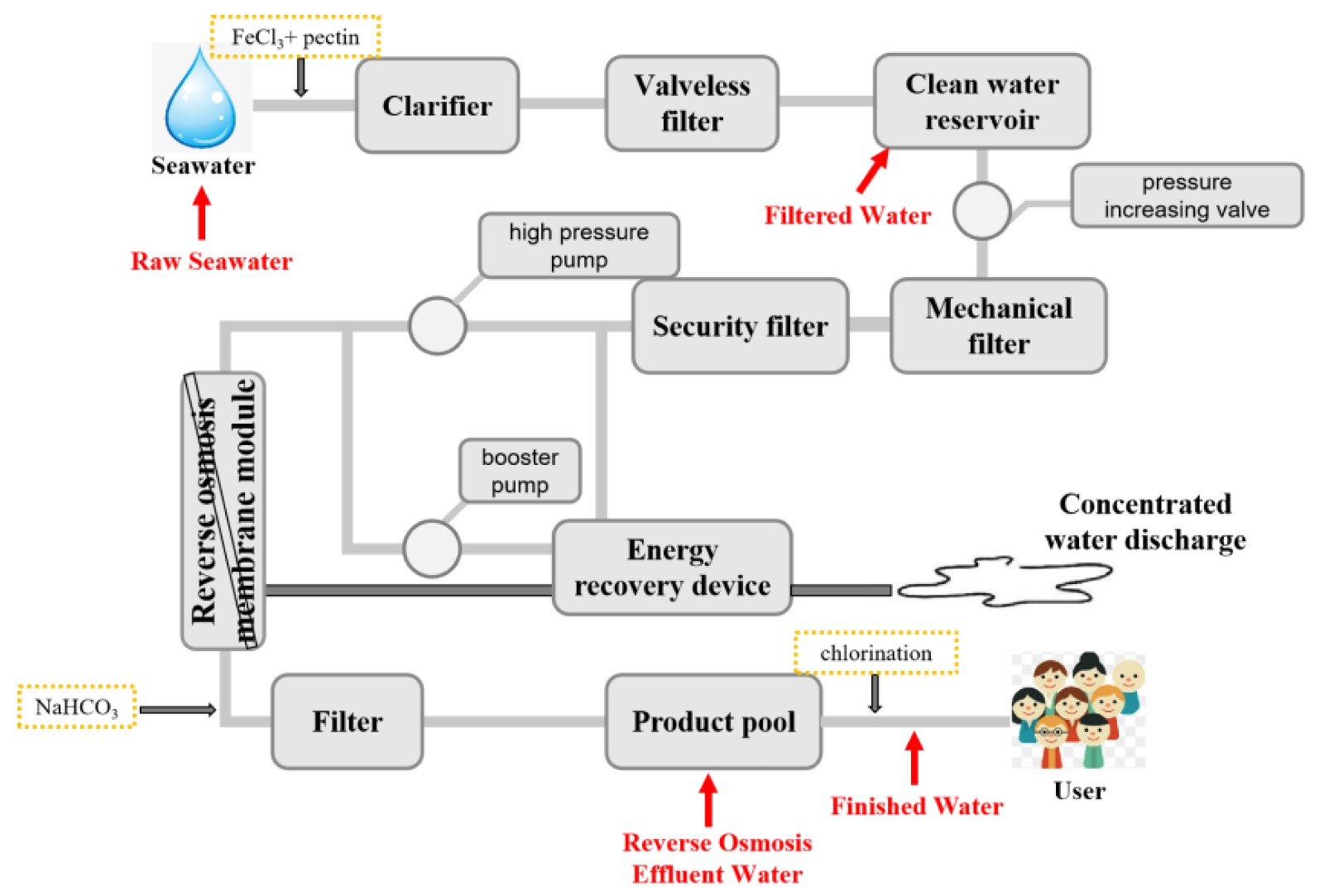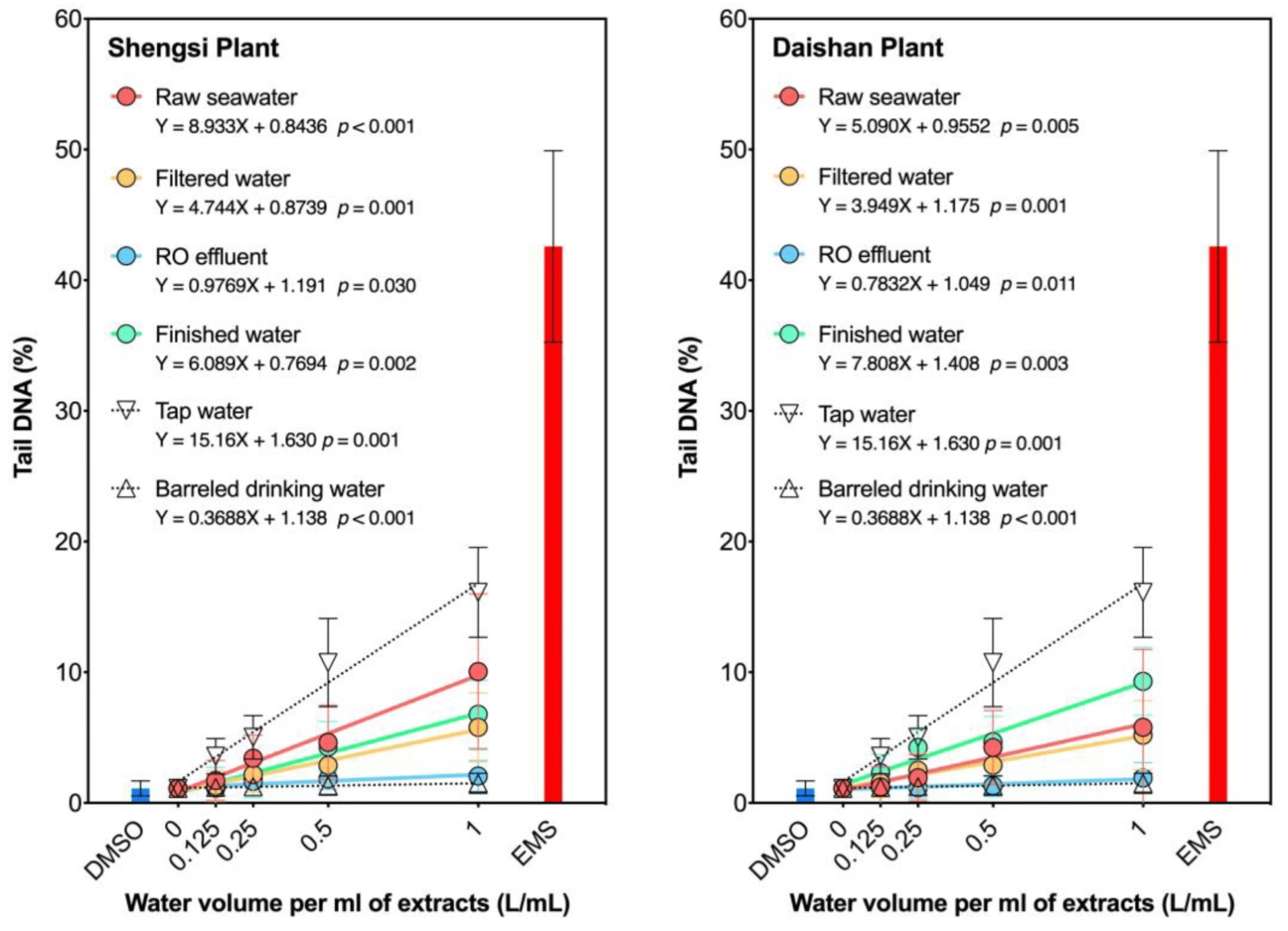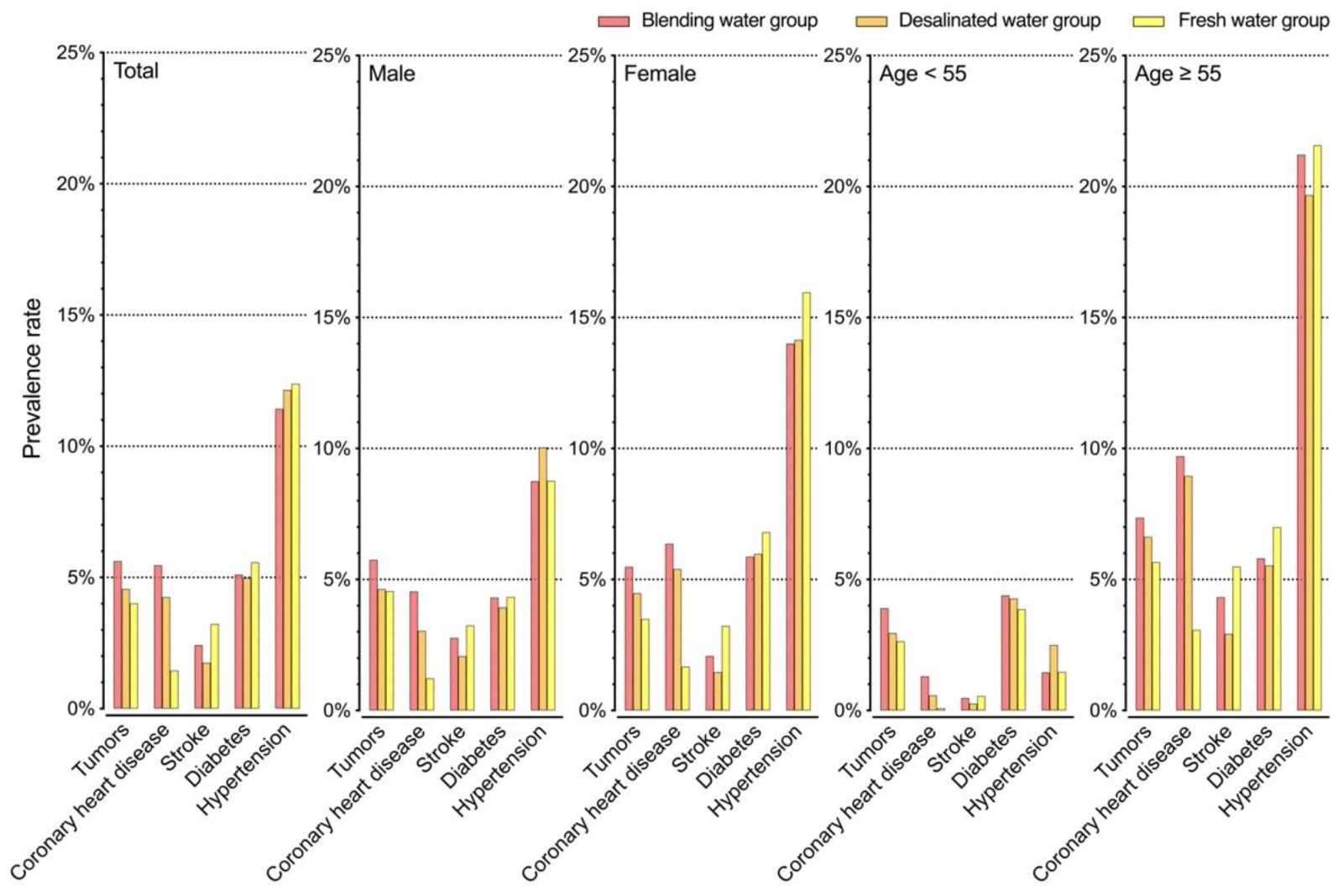Country:
Zhoushan, China
Location:
Shengsi Island and Daishan Island
Time period :
October to December 2020
Implementing Institution/ Organization:
1. Zhoushan Center for Disease Control and Prevention, Zhoushan, China
2. College of the Environment & Ecology, Xiamen University, Xiamen, China
3. Institute of Urban Environment, Chinese Academy of Sciences, Xiamen, China
Goals
1. Assess the genotoxicity of desalinated seawater produced by reverse osmosis (RO) at two desalination plants in Zhoushan, China.
2.
Compare the genotoxicity of desalinated seawater with that of freshwater, focusing on the DNA damage potential of organic extracts in treated water.
3.
Evaluate health risks associated with drinking desalinated seawater, including potential correlations with chronic diseases like hypertension and coronary heart disease.
4.
Analyze water quality parameters across stages of the desalination process to determine compliance with national drinking water standards, especially regarding the removal of harmful byproducts and essential minerals
Objectives
1. Investigate the genotoxic effects of disinfection by-products (DBPs) in desalinated seawater produced by reverse osmosis (RO) processes.
2.
Assess water quality parameters across different stages of the desalination process, including raw seawater, filtered water, RO effluent, and finished water, to ensure compliance with Chinese national drinking water standards.
3.
Examine the potential DNA damage in cells caused by organic extracts from desalinated seawater, using the single-cell gel electrophoresis (SCGE) assay.
4.
Compare the genotoxicity of desalinated water with conventional freshwater sources and bottled drinking water.
5.
Evaluate the health implications for residents consuming desalinated seawater over time, including assessing correlations between water source and the prevalence of chronic health conditions, such as tumors, coronary heart disease, and hypertension
Methodology (approach)
1. Water Sample Collection:
+
Samples were collected monthly from October to December 2020 from two desalination plants, Shengsi and Daishan, located on Zhoushan Islands.
+
Water samples were taken at four stages of the treatment process: raw seawater, filtered water, RO effluent, and finished water.
2.
Water Quality Analysis:
+
Various parameters, including turbidity, pH, chemical oxygen demand (COD), total dissolved solids (TDS), total hardness, ammonia nitrogen, chloride, sulfate, boron, calcium, standard plate count bacteria, total coliforms, and Escherichia coli, were analyzed.
+
Field measurements used portable equipment, while laboratory analyses adhered to Chinese national standards (GB/T 5750-2006).
3.
Genotoxicity Analysis Using the Single-Cell Gel Electrophoresis (SCGE) Assay:
+
Organic compounds from water samples were extracted and concentrated using solid-phase extraction.
+
The SCGE (comet assay) was used to detect DNA damage in HL-60 human leukemia cells exposed to these extracts. DNA damage was quantified using tail DNA percentage, providing a measure of genotoxicity.
4.
Comparison of Genotoxicity across Treatments:
+
Genotoxicity was assessed across different treatment stages to observe changes, particularly in relation to filtration, RO treatment, and post-chlorination effects.
+
Tap water and bottled drinking water were also tested to compare genotoxicity levels.
5.
Health Risk Assessment:
+
A health survey was conducted on residents consuming desalinated seawater, freshwater, and blended water. This survey compared the prevalence of tumors, coronary heart disease, stroke, diabetes, and hypertension across the three groups.
+
Statistical analyses were used to correlate health risks with long-term consumption of desalinated water.
6.
Data Analysis:
+
Genotoxicity data were analyzed using regression models to calculate DNA damage per unit volume (m-value), and fold-change (FC) values were used to interpret genotoxicity variations across treatment stages.
+
The health survey data were statistically compared across groups to determine health impacts associated with different water sources
Study results
1. Water Quality Compliance:
+The desalinated water from both plants met Chinese national drinking water standards except for boron content, which was slightly above the limit. Essential minerals like calcium and magnesium were found in very low concentrations in the finished water, highlighting a potential health concern due to low mineral levels.
2. Genotoxicity Findings:
+The desalination process, specifically filtration and reverse osmosis (RO) treatment, significantly reduced the genotoxicity of raw seawater.
+
However, post-chlorination increased genotoxicity by 6.23 and 9.97 times in the Shengsi and Daishan plants, respectively, likely due to the formation of brominated and iodinated disinfection by-products (DBPs) which are more cytotoxic and genotoxic than chlorinated analogues.
+
Despite this increase, the finished desalinated water demonstrated a lower genotoxicity than tap water sourced from freshwater, indicating that desalinated water may be relatively safer in terms of genotoxicity.
3.
Health Risk Assessment:
+
Health surveys revealed that residents consuming desalinated or blended water had a higher prevalence of tumors and coronary heart disease compared to those consuming freshwater.
+
The group consuming freshwater had the lowest prevalence of these diseases, suggesting that long-term consumption of desalinated water, which lacks essential minerals, might increase the risk of some chronic diseases.
The findings also suggested that the potential health risks might not arise directly from desalination but possibly from pipeline delivery or blending with freshwater sources.
4.
Comparative Genotoxicity of Water Treatment Methods:
+
The study found that genotoxicity levels in desalinated water were comparable to bottled drinking water and significantly lower than conventional tap water. In contrast, some freshwater-source drinking water treatment processes reported higher genotoxicity levels than desalinated seawater.
5.
Overall Conclusions:
+
Desalinated seawater was deemed relatively safe regarding genotoxicity, though long-term health risks from low mineral content and pipeline delivery remain concerns.
+
Further improvements are recommended in the desalination process, especially post-treatment chlorination, to minimize genotoxicity risks.
Conclusions
1. Desalinated Seawater Quality and Safety:
+
Seawater desalination using reverse osmosis (RO) effectively reduces the genotoxicity of seawater and meets most national drinking water standards in China, though boron levels exceeded the standard and mineral content was very low in the finished water. These findings suggest that desalinated water is a viable alternative for addressing freshwater scarcity, particularly in island regions.
2.
Genotoxicity and Health Implications:
+
While RO treatment effectively minimized genotoxicity, chlorination after desalination increased genotoxicity significantly, likely due to the formation of brominated and iodinated disinfection by-products (DBPs).
+
Residents who consumed desalinated or blended water showed higher prevalence rates of tumors and coronary heart disease compared to those consuming natural freshwater, suggesting that desalinated water may carry some health risks, potentially from low essential mineral content and DBP exposure.
3.
Comparison with Other Water Treatment Methods:
+
The genotoxicity of desalinated water was found to be lower than that of conventional tap water sourced from freshwater, suggesting that desalination could be safer in terms of DNA damage potential.
4.
Recommendations for Future Improvements:
+
To enhance safety, the study recommends improvements in post-treatment processes to reduce genotoxicity after desalination, particularly in controlling DBP formation during chlorination.
+
Further research is suggested to examine the long-term health impacts of drinking low-mineral desalinated water and to assess strategies for mineral reintroduction to improve overall health outcomes for consumers.
Recommendations
1. Improve Post-Treatment Processes:
+
Implement strategies to control or modify chlorination to reduce the formation of brominated and iodinated disinfection by-products (DBPs), which contribute to genotoxicity. Alternative disinfection methods or optimized chlorination procedures could minimize harmful by-products.
2.
Mineral Reintroduction:
+
Consider remineralizing desalinated water to address deficiencies in essential minerals like calcium and magnesium, which are often removed during the desalination process. Reintroduction of minerals could help reduce potential long-term health risks associated with consuming low-mineral water.
3.
Regular Monitoring of DBPs and Genotoxicity:
+
Establish routine monitoring of DBPs and genotoxicity levels in desalinated water to ensure compliance with health safety standards. This approach would allow early detection of potential health risks, particularly in areas with high bromine and iodine in the raw seawater.
4.
Further Health Impact Studies:
+
Conduct additional long-term studies to evaluate the health impacts of consuming desalinated water, especially focusing on chronic diseases like cancer and cardiovascular issues. These studies would provide more comprehensive data on the health implications of long-term desalinated water consumption.
5.
Optimize Desalination Processes for Bromine and Iodine Removal:
+
Research and develop methods for bromine and iodine removal during desalination, as their presence in raw seawater contributes to the formation of more cytotoxic and genotoxic DBPs during chlorination. Techniques such as advanced filtration could help reduce these precursors.
6.
Public Health Awareness:
+
Increase awareness among consumers about the potential health implications of drinking desalinated water, particularly regarding mineral deficiencies. Public health information can encourage balanced diets or mineral supplementation where necessary.
Lessons learned
1. Importance of Post-Treatment in Desalination:
+
Effective desalination does not end with the removal of salts; post-treatment processes are crucial. Chlorination, while essential for disinfection, can introduce genotoxic compounds, emphasizing the need to balance safety and health impacts in post-treatment.
2.
Health Risks from Low Mineral Content:
+
Removing minerals during desalination can lead to health risks when desalinated water becomes a primary source. Essential minerals like calcium and magnesium are beneficial to health, and their absence in desalinated water raises concerns for long-term consumption, highlighting the need for reintroducing minerals in treated water.
3.
Role of Bromine and Iodine in Genotoxicity:
+
Bromine and iodine levels in seawater play a significant role in the formation of harmful by-products during disinfection. Understanding regional variations in raw water composition is vital to anticipate and mitigate these risks, as they contribute to DBPs that are more toxic than their chlorinated counterparts.
4.
Value of Genotoxicity Testing in Water Safety:
+
Conventional water quality parameters alone may not fully capture health risks; genotoxicity testing provides valuable insight into the potential DNA damage risks associated with drinking water, offering a more comprehensive approach to water safety evaluation.
5.
Need for Public Health Studies on Desalinated Water:
+
The study underscored the importance of long-term public health assessments for communities relying on desalinated water. Health data collection and analysis can reveal trends in disease prevalence and guide safer desalination practices.
6.
Challenges with Blending Desalinated and Fresh Water:
+
Blending desalinated water with freshwater introduces unique challenges, as it can lead to the formation of additional DBPs due to variations in organic and inorganic matter. Understanding these interactions is key to preventing unintended health risks in water distribution systems.
References (resources) Found is the case study
+ For full citation:
Zhang, Y., Xiao, Y., Xian, X., Wan, K., Yu, X., & Ye, C. (2023). "Genotoxicity and Health Risk of Seawater Desalination Based on Reverse Osmosis: A Case Study of Two Seawater Desalination Plants in Zhoushan, China." Water, 15(13), 2470.
https://doi.org/10.3390/w15132470.
+
Key resources referenced in the study:
-National Standards for Drinking Water Quality (China):
*GB/T 5750-2006: Chinese standard for drinking water quality testing.
*GB 5749-2006: Standards for drinking water quality.
*GJB1335-92: Hygienic standards for low mineralization drinking water.
-Genotoxicity and Mutagenicity Tests:
*Singh, N.P. et al. (1988). "A simple technique for quantitation of low levels of DNA damage in individual cells." Experimental Cell Research.
Collins, A.R. (2004). "The comet assay for DNA damage and repair." Molecular Biotechnology.
-Studies on DBPs and Water Treatment:
*Richardson, S.D. et al. (2008). "Occurrence and mammalian cell toxicity of iodinated disinfection by-products in drinking water." Environmental Science & Technology.
Yang, Y. et al. (2014). "Toxic impact of bromide and iodide on drinking water disinfected with chlorine or chloramines." Environmental Science & Technology.
-Desalination and Health Risks:
*Nriagu, J., Darroudi, F., Shomar, B. (2016). "Health effects of desalinated water: Role of electrolyte disturbance in cancer development." Environmental Research.
*Agus, E., Sedlak, D.L. (2009). "Disinfection by-products and their potential impact on the quality of water produced by desalination systems: A literature review." Desalination.
-Chemical and Toxicological Studies on Water Quality:
*Kitis, M. et al. (2002). "Probing reactivity of dissolved organic matter for disinfection by-product formation using XAD-8 resin adsorption and ultrafiltration fractionation." Water Research.
Magara, Y. et al. (1996). "The behavior of inorganic constituents and disinfection byproducts in reverse osmosis water desalination process." Water Science and Technology.



